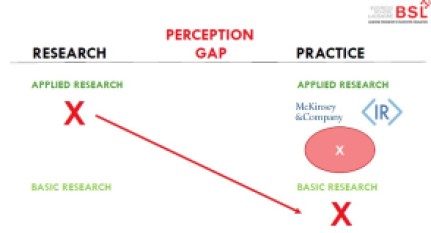The Swiss National Fund (SNF) is a key provider of research funding in Switzerland. The National Research Programme 73 (NRP73) is a CHF 20 mio. research program that supports and encourages applied research across all fields to help achieve a sustainable economy. After a lengthy application and screening process, 25 projects were selected across all major public research institutions in Switzerland. The ambition of the program is that these 25 projects deliver not just independent research outcomes but collaborate among them and also with the stakeholders they seek to influence. That is a high call and one that researchers traditionally find difficult to embrace. It is often hard enough to collaborate within a multi-stakeholder project that there is little room to investigate further opportunities beyond. My job as the opening keynote speaker of the NRP73 kick-off session with about 100 of the scientists present in one room was “to inspire them”.
I chose to address three key questions that would contextualize their projects and to develop key emerging challenges resulting from this investigation. Knowing that there would be an expert in the room with more knowledge than me on pretty much any point I would address, I needed to be careful in framing my assumptions and conclusions. The three questions addressed the role of sustainability research in Switzerland, the ability to ensure relevance, and how to achieve impact through sustainability research. Figure 1 shows an overview of the emerging challenges I have identified.

Figure 1: Overview of the emerging challenges resulting from the 3 questions
In the context of the Gapframe (see Figure 2), I suggested that each project team assesses their project with regards to the issue it addresses. Some concern issues where Switzerland is particularly strong internationally and where solutions can be pioneered as a result of new insights. Other issues are of key priority for Switzerland itself and solutions will need to be innovated to ensure local relevance. Further issues may be of critical relevance globally and Swiss solutions can be scaled and shared as best practices.

Figure 2: Overview of the emerging challenges resulting from the 3 questions
To provoke thinking, I suggested there was a perception gap between how practice looks at “applied research” and how science looks at it (see Figure 3). This generated more nodding than I had dared to hope for. I even got a positive reaction to my suggestion to consider taking an action research stance, whereby the researcher assumes a subjective partner rather than an objective observer perspective. Very promising indeed!

Figure 3: The perception gap between science and practice in refereeing to “applied research”
When looking at these challenges, I remembered the insight of Insight of Andrew Hoffman in his book “How Culture Shapes the Climate Change Debate”: more knowledge doesn’t change minds. So how do we maximize the value of all the knowledge that will be generated by these 25 projects? My recommendation was framed as an attempt to answer the three questions and I highlighted that the secret lies in the research process. I summarized the elements of a success research process in 7 points:
- PURPOSE FOCUS
- DYNAMIC
- INCLUSIVE
- CO-CREATIVE
- IMPACT ORIENTED
- ONGOING DISSEMINATION
- ADAPTIVE OUTPUT
A purpose focus entails verifying again & again: does this project truly serving society, and if so how? A dynamic process needs to integrate new developments and may embrace an action research stance. Being inclusive means involving those stakeholders that are intended recipients the project seeks to influence. A co-creative research projects includes being truly “applied” from a user-perspective rather than a research perspective and includes integrating feedback. Being impact oriented is about ensure that the project is truly influencing those who matter when it matters. Ensuring ongoing dissemination means that external communications starts from the very beginning of the project, not only once first results are in. Finally, achieving an adaptive output includes negotiating and agreeing on value of improving output along the way according to changing context.
In conclusion, I suggested that it is of prime importance to review and adapt both the research process and outcome in an adaptive and dynamic way throughout the project lifetime.

 Author: Katrin Muff, PhD
Author: Katrin Muff, PhD
Active in thought leadership, consulting & applied research in sustainability & responsibility, and directing the DAS & DBA programs

